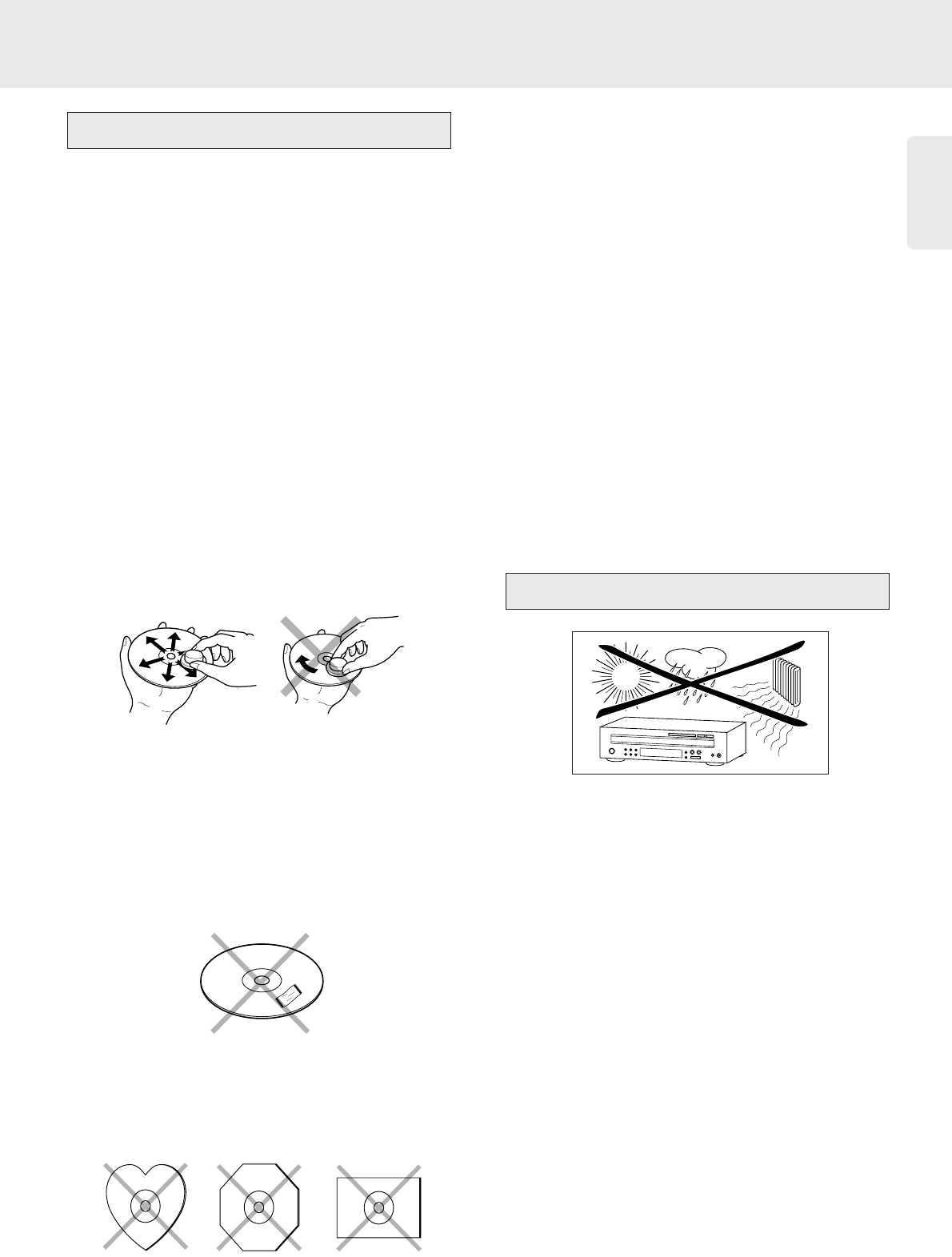
English
General Information
The glossy side shining like a rainbow is the front side
of the disc, and the side on which the label is printed
is the back.
Unlike conventional turntables for playing analog discs,
the CC4300 reads the information recorded on the disc
from underneath without contacting it using a beam of
laser light. Therefore, the performance of a compact
disc will not degrade like conventional analog records.
Handle discs carefully so as not to damage or
scratch the front side.
To protect the disc, avoid placing it in the following
locations:
• In direct sunlight or near a source of heat like a
heater.
• In a place which is damp or dirty.
• In a place which could be exposed to rain, such as
near a window.
Always keep the disc surface clean.
Up to six billion data units are recorded on the front side
of the disc. When cleaning the disc surface, always be
sure to use a special compact disc cleaner and wipe as
shown below.
• Do not use conventional record cleaner for analog
records, as this will adversely affect the disc surface.
Store discs properly by placing them in their disc
cases.
• Do not attach a piece of paper or sticker on the
label side of disc. When a disc has a piece of
plastic tape or rental CD label with paste protruded
from the edge or when a disc has a trace of such a
sticky object, do not attempt to play the disc. If such
a disc is played on the CD player, impossibility of
taking out the disc or other malfunction may result.
• Write only on the printed side of a CD-R or CD-
RW, and only with a soft felt-tipped pen.
• Do not use a disc with a special shape.
Do not attempt to play a disc with a special shape
such as a heart-shaped disc or octagonal disc.
Otherwise the equipment malfunction may result.
❖ Playing CD-RW discs
This unit can play back the CD-RW (ReWritable) discs
as well as ordinary music CD and CD-R (Recordable)
discs.
• The CD-R and CD-RW discs should contain
properly-recorded TOC information so that they
can be played back. With the CD recorder system,
writing the TOC information in a disc is referred to
as finalizing the disc. A disc cannot be recognized
as a CD disc and played back unless it has been
finalized properly. For details, please read the
instruction manual provided with a CD recorder.
• TOC stands for Table Of Contents and contains
information such as the total number of tracks and
total playing time of the disc.
• This unit can play only the discs recorded in the
CD-DA format designed for music reproduction.
Do not attempt to play a disc containing other data,
such as a CD-ROM for PCs, on this unit.
• As the playback of a CD-RW disc necessitates
partial change of the player setup, it may take
longer time for reading the TOC information than
when a music CD or CD-R disc is played.
• A few CD-RW discs may not be played in some
reason. Please use another disc to play.
• Place the CD player on a firm, flat surface.
• Keep away from domestic heating equipment and
direct sunlight.
• In a cabinet, allow about 2 inches of free space all
around the player for adequate ventilation.
• If the CD player cannot read CDs correctly, use a
commonly-available cleaning CD to clean the lens
before taking the CD-player to be repaired. Other
cleaning methods may destroy the lens. Always
keep the tray closed to avoid dust on the lens.
• When it is moved from a cold to a warm environment,
allow the CD player to acclimatize for at least 2 hours
in order to avoid damage. When suddenly placed in
a warm environment, the lens may cloud over.
Playing an CD will not be possible then. Wait until
the moisture evaporates.
• Do not use the CD player under extremely damp
conditions.
• Do not expose discs to direct sunlight, high
humidity or high temperature for a long time.
Attention!
If the appliance is not used or operated in
accordance with the instructions, this may result
in exposure to dangerous radiation or other risks.
Only authorized technicians are allowed to open
the appliance casing or to perform repairs or
maintenance.
Placement
Compact Discs
3


















